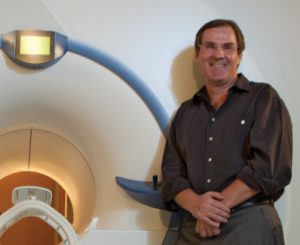By Paul Atkinson
The McConnell Brain Imaging Centre’s ACE NeuroImaging Laboratory and the Montreal Consortium for Brain Imaging Research are getting a clearer picture (literally) of what Alzheimer’s disease does to our brains.
We’re all too familiar with what Alzheimer’s disease looks like from the outside. The classic symptom is disruptive memory loss, but there are other indications of a brain that just isn’t working the way it once did. There may be extreme confusion over time and place. Debilitating problems with speech and language. Dramatic changes in personality, even. But what does it look like inside that misfiring brain? If you were to look at a police line-up of an Alzheimer’s brain surrounded by healthy organs, could you ID the perpetrator based on physical characteristics alone? If so, what makes it stand out? Those are the questions that Alan Evans is trying to answer.

Originally trained in physics at Liverpool University, with a PhD in biophysics, Evans uses a technique developed at McGill that generates 3D MRI images of the living, developing brain—scans that can be repeated over time to facilitate longitudinal studies that follow disease progression. The new technology enabled him to discover the link between the thinning of the brain’s cortex and mild cognitive impairment (MCI) as well as Alzheimer’s disease.
“If you can start to understand the mechanisms of neuropathology as it evolves in living subjects, you have a better understanding of the process of the disease and can ultimately do something about it,” states Evans. “Through imaging, we’re getting a better handle on how a normal brain’s networks change over time in comparison to the networks from a brain progressing to Alzheimer’s.”
Evans also serves as Principal Investigator of the national CBRAIN and international GBRAIN research networks. Funded by Canada’s Advanced Research and Innovation Network (CANARIE), the networks bring together research from many brain imaging centres around the world into a central, unified platform. Using seven supercomputers housed across Canada, the CBRAIN platform lets researchers share 3D and 4D (how a 3D image changes over time) brain imaging data from clinical trials and other large research projects, allowing researchers to explore existing data, process their own data, and add their findings to ongoing research. Remote users can apply their findings to large databases stored at remote locations and visualize the results as 3D maps in real time. Someone studying Alzheimer’s disease or, at the other end of the age spectrum, autism, can measure the cortical thickness in hundreds of individual brains — or study the physiological changes in one brain over the span of milliseconds or even its structural changes over years.
Dementia on the rise
According to the Alzheimer’s Society, one Canadian develops dementia every five minutes. By 2038, this will become one person every two minutes, totaling more than 257,000 people per year.
“CBRAIN is an engine for the common good,” says Evans. “The techniques we are using are allowing us to build up large databases of information from across the globe to attack diseases such as Alzheimer’s.”
Evans points out that with CBRAIN and GBRAIN in place, researchers are able to conduct larger studies using thousands of subjects — studies that are simply impossible to do in a single lab. This shared resource also reduces the need for isolated researchers to duplicate work that’s already been done elsewhere, allowing for more and larger-scale Alzheimer’s- related research projects to see the light of day — helping researchers push ahead in understanding the mechanisms of the disease and how to attack it head-on.
“We’re trying to combine three different domains of data acquisition — behaviour, imaging and genetics — in some multi-variant sense to see if there’s a cluster of deficits that are most strongly predictive of disease progression,” says Evans. “What are we seeing as someone progresses from having, say, mild cognitive impairment to Alzheimer’s disease? That’s what neuroscience is today.”
Alan Evans is a James McGill Professor of Neurology, Psychiatry and Biomedical Engineering and a CIHR Senior Scientist. He is the director of the McConnell Brain Imaging Centre’s ACE NeuroImaging Laboratory and the Montreal Consortium for Brain Imaging Research. He is also Principal Investigator of the CBRAIN and GBRAIN projects, funded by Canada’s Advanced Research and Innovation Network (CANARIE).
